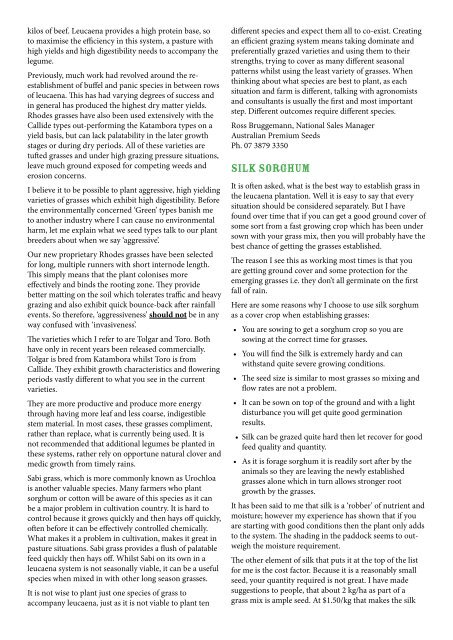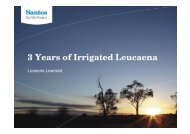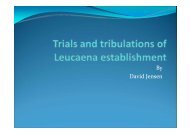THE LEUCAENA NETWORK NEWS
THE LEUCAENA NETWORK NEWS
THE LEUCAENA NETWORK NEWS
Create successful ePaper yourself
Turn your PDF publications into a flip-book with our unique Google optimized e-Paper software.
kilos of beef. Leucaena provides a high protein base, so<br />
to maximise the efficiency in this system, a pasture with<br />
high yields and high digestibility needs to accompany the<br />
legume.<br />
Previously, much work had revolved around the reestablishment<br />
of buffel and panic species in between rows<br />
of leucaena. This has had varying degrees of success and<br />
in general has produced the highest dry matter yields.<br />
Rhodes grasses have also been used extensively with the<br />
Callide types out-performing the Katambora types on a<br />
yield basis, but can lack palatability in the later growth<br />
stages or during dry periods. All of these varieties are<br />
tufted grasses and under high grazing pressure situations,<br />
leave much ground exposed for competing weeds and<br />
erosion concerns.<br />
I believe it to be possible to plant aggressive, high yielding<br />
varieties of grasses which exhibit high digestibility. Before<br />
the environmentally concerned ‘Green’ types banish me<br />
to another industry where I can cause no environmental<br />
harm, let me explain what we seed types talk to our plant<br />
breeders about when we say ‘aggressive’.<br />
Our new proprietary Rhodes grasses have been selected<br />
for long, multiple runners with short internode length.<br />
This simply means that the plant colonises more<br />
effectively and binds the rooting zone. They provide<br />
better matting on the soil which tolerates traffic and heavy<br />
grazing and also exhibit quick bounce-back after rainfall<br />
events. So therefore, ‘aggressiveness’ should not be in any<br />
way confused with ‘invasiveness’.<br />
The varieties which I refer to are Tolgar and Toro. Both<br />
have only in recent years been released commercially.<br />
Tolgar is bred from Katambora whilst Toro is from<br />
Callide. They exhibit growth characteristics and flowering<br />
periods vastly different to what you see in the current<br />
varieties.<br />
They are more productive and produce more energy<br />
through having more leaf and less coarse, indigestible<br />
stem material. In most cases, these grasses compliment,<br />
rather than replace, what is currently being used. It is<br />
not recommended that additional legumes be planted in<br />
these systems, rather rely on opportune natural clover and<br />
medic growth from timely rains.<br />
Sabi grass, which is more commonly known as Urochloa<br />
is another valuable species. Many farmers who plant<br />
sorghum or cotton will be aware of this species as it can<br />
be a major problem in cultivation country. It is hard to<br />
control because it grows quickly and then hays off quickly,<br />
often before it can be effectively controlled chemically.<br />
What makes it a problem in cultivation, makes it great in<br />
pasture situations. Sabi grass provides a flush of palatable<br />
feed quickly then hays off. Whilst Sabi on its own in a<br />
leucaena system is not seasonally viable, it can be a useful<br />
species when mixed in with other long season grasses.<br />
It is not wise to plant just one species of grass to<br />
accompany leucaena, just as it is not viable to plant ten<br />
different species and expect them all to co-exist. Creating<br />
an efficient grazing system means taking dominate and<br />
preferentially grazed varieties and using them to their<br />
strengths, trying to cover as many different seasonal<br />
patterns whilst using the least variety of grasses. When<br />
thinking about what species are best to plant, as each<br />
situation and farm is different, talking with agronomists<br />
and consultants is usually the first and most important<br />
step. Different outcomes require different species.<br />
Ross Bruggemann, National Sales Manager<br />
Australian Premium Seeds<br />
Ph. 07 3879 3350<br />
silk sorghum<br />
It is often asked, what is the best way to establish grass in<br />
the leucaena plantation. Well it is easy to say that every<br />
situation should be considered separately. But I have<br />
found over time that if you can get a good ground cover of<br />
some sort from a fast growing crop which has been under<br />
sown with your grass mix, then you will probably have the<br />
best chance of getting the grasses established.<br />
The reason I see this as working most times is that you<br />
are getting ground cover and some protection for the<br />
emerging grasses i.e. they don’t all germinate on the first<br />
fall of rain.<br />
Here are some reasons why I choose to use silk sorghum<br />
as a cover crop when establishing grasses:<br />
• You are sowing to get a sorghum crop so you are<br />
sowing at the correct time for grasses.<br />
• You will find the Silk is extremely hardy and can<br />
withstand quite severe growing conditions.<br />
• The seed size is similar to most grasses so mixing and<br />
flow rates are not a problem.<br />
• It can be sown on top of the ground and with a light<br />
disturbance you will get quite good germination<br />
results.<br />
• Silk can be grazed quite hard then let recover for good<br />
feed quality and quantity.<br />
• As it is forage sorghum it is readily sort after by the<br />
animals so they are leaving the newly established<br />
grasses alone which in turn allows stronger root<br />
growth by the grasses.<br />
It has been said to me that silk is a ‘robber’ of nutrient and<br />
moisture; however my experience has shown that if you<br />
are starting with good conditions then the plant only adds<br />
to the system. The shading in the paddock seems to outweigh<br />
the moisture requirement.<br />
The other element of silk that puts it at the top of the list<br />
for me is the cost factor. Because it is a reasonably small<br />
seed, your quantity required is not great. I have made<br />
suggestions to people, that about 2 kg/ha as part of a<br />
grass mix is ample seed. At $1.50/kg that makes the silk






